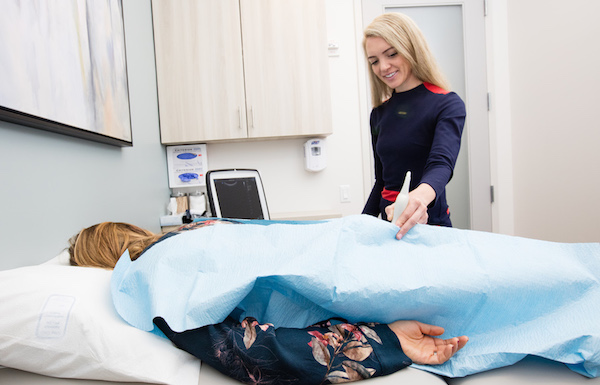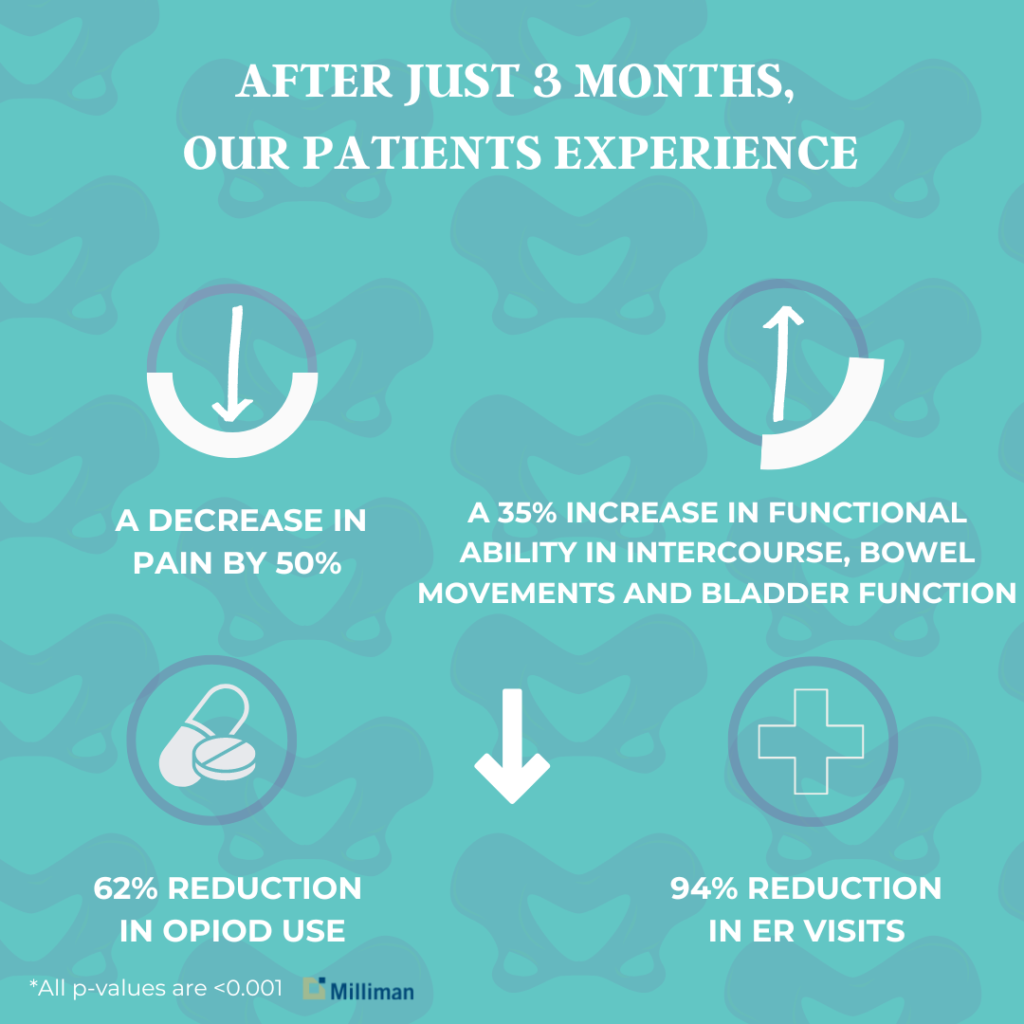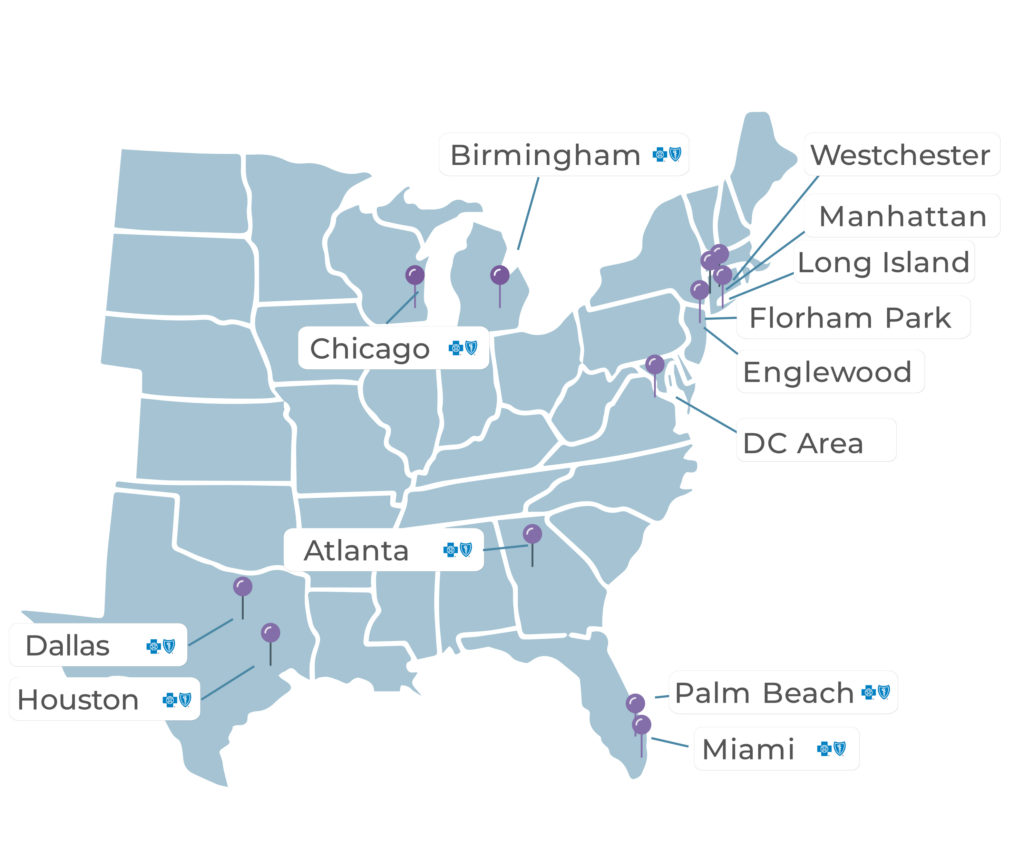At PRM, our unique in-office, ultrasound guided approach to the pelvis is the first of its kind in the country.
Pelvic Nerve and Muscle Treatments: The Basics
![]()
Ultrasound-guided pelvic peripheral nerve blocks in combination with pelvic floor trigger point injections can be an important part of pelvic floor treatment, for pelvic pain patients’ symptoms and conditions!
The key to success is all of it at once. Patients come to us after 2-5 surgeries, medications, months and years of treatments, including pelvic floor physical therapy, with minimal sustained relief. We have found that an approach where things are done at the same time, not in piecemeal, is the secret sauce.
Ultrasound is a safe, non-invasive technology that helps pinpoint the muscle locations requiring relief.
The nerve blocks use the gentle pain reliever lidocaine and sometimes use anti-inflammatory medication.
The result is an improvement in the pelvic floor muscular tightness and and a decrease in the pelvic nerve irritation and inflammation. In addition, the treatment works to increase blood flow to help heal the nerves and muscles of the pelvis.
Our pelvic pain specialists are able to provide an internal evaluation and use ultrasound to guide treatment externally – bringing relief to pelvic pain sufferers everywhere.
This is an office based treatment with no anesthesia and no down time. Patients go on with their day directly after.
Common Symptoms Treated
FEMALE
• Pain During or After Intercourse
• Pain with Endometriosis
• Pain with Periods
• Lower Abdominal Pain
• Vulvar Pain or Vulvodynia
• Vaginismus
• Postpartum Pelvic Pain
MALE
• Chronic Prostatitis
• Pain with Erection or Ejaculation
• Numbness and Tingling in Testicles or Penis
• Lower Abdominal or Groin Pain
BOTH MALE +FEMALE
• Interstitial Cystitis/Bladder Pain Syndrome
• Urinary Urgency or Frequency or Burning with Urination
• Perineal Pain
• Sacral, Tailbone, Hip, or Buttock Pain
• Pain with Sitting
• Persistent Sexual Arousal
• Rectal Pain or Burning
• Pain Related to Bowel Movement

Our pelvic nerve and muscle treatments, also called ultrasound-guided pelvic peripheral nerve blocks and trigger point injections, can be an important part of pelvic floor treatment. Ultrasound is a safe, non-invasive technology that helps pinpoint the muscle locations requiring relief. The injections are an anti-inflammatory medication with the gentle pain reliever lidocaine. The result is an improvement in the muscular and nerve-based disarray, along with increased blood flow which returns healthy levels of oxygen to the site. Peripheral nerve blocks are also used in some cases.
What Is a Trigger Point?
Trigger points are painful knots or nodules of muscle spasm that form when muscles do not relax. Many times, such knots can be felt under the skin. Muscle Overload, acute trauma or even a series of minor injuries can cause trigger points to form. In some cases, trigger points may irritate the nerves at a distance and cause referred pain – that is, pain felt in another part of the body, instead of where the underlying cause is located.
Contact Us to Book a Consultation
How Does PRM’s Office Based Treatment Help With The Pelvic Nerves?
At PRM, we are performing external ultrasound guided pelvic peripheral nerve blocks with a hydrodissection technique to treat the inflamed and irritated nerves of the pelvis that are contributing to pelvic pain symptoms.
Our treatments help the pelvic nerves by:
- Desensitizing the hyperactive pelvic nerves to a more calm state
- Increasing the space along the fascial planes where the nerves flow so the nerves can flow more freely and allow for more blood flow and oxygenation to them so they can heal
- Placing local medication around the nerve to directly target the pelvic nerve inflammation and reverse it.
How Does a Trigger Point Injection Work?
We perform external ultrasound guided trigger point injections. Trigger point injections are able to get medication directly into the muscle knot and can often release the spasm immediately. These injections are an important part of pelvic floor treatment at our practice. The technique is also used when the pain in the body’s fascia does not respond to other treatments.
What To Do Before an Ultrasound Guided Pelvic Nerve and Muscle Treatment
Before coming in for a treatment, make sure to stay hydrated and do NOT come on an empty stomach. If needed take prescription strength ibuprofen 1 hour before treatment.
What to Expect with Pelvic Nerve and Muscle Treatments
Our peripheral nerve block and trigger point injections are given in our office and usually take a few minutes. The injection feels similar to getting a flu shot. Several pain locations may be treated in one visit. The result is increased blood flow, which returns healthy levels of oxygen to the site as well as decreased irritation and inflammation around the nerves that cause your pelvic pain.
Do we go inside with the ultrasound probe?
No. In an ultrasound exam, a transducer (probe) is placed directly on the skin. A thin layer of gel is applied to the skin so that the ultrasound waves are transmitted from the transducer through the gel into the body.

Why do we use ultrasound guidance for our procedures?
Typically when we see a patient for the first time we do not use ultrasound to diagnose the patient as the ultrasound would not be able to show us the tone of the pelvic floor. The best diagnostic tool is our physical examination including internal examination through the vagina or rectum. However, we do use ultrasound for guidance. Ultrasound imaging helps the doctors during procedures (intraarticular joint injections, trigger point injections as well as peripheral nerve blocks) to locate where our needle is in relationship to the nerves, arteries and muscles. Ultrasound guidance has been recently associated with a reduction in complication rates and an increase in success rates.
Which nerve blocks are you using the ultrasound for?
We use the ultrasound to help guide us for all of our nerve blocks. Based on physical examination findings we are able to selectively block the branches of the Pudendal nerve including, the Dorsal Nerve to the Clitoris, the Perineal nerve and the inferior rectal nerve. If necessary, we also use ultrasound guidance to block the ilioinguinal, iliohypogastric, genitofemoral and posterior femoral cutaneous nerve and its branches.
Which trigger point injections do you use the ultrasound for?
It is important to do all the trigger point injections with ultrasound guidance “live” to ensure we are reaching the correct muscle in the levator ani (puboretalis, pubococcygeus, iliococcygeus) as well as obturator internus and piriformis muscles. An added benefit is this is more comfortable for patients. They can go on with their day directly after.
What are the risks and benefits of using ultrasound?
Ultrasound imaging has been used for over 20 years and has an excellent safety record. There is no radiation, so it does not have the same risks as X-rays or other types of imaging systems that use radiation.
Why a series of injections?
Trigger point injections work best in a series, as it can take multiple injections to reset the length tension curve of the muscle, and retrain it to remain in the lengthened state. There is a positive accumulative effect with each treatment. Due to the large size of the pelvic floor, and the large number of branches off of the pudendal nerve, the best chance for pain relief is by doing a series of nerve blocks so that all of the branches off the nerve can be treated. In addition, you are repetitively desensitizing the peripheral nerves and muscles of the pelvis that are causing your pelvic pain symptoms.
What To Do After Pelvic Nerve and Muscle Treatment
Patients are able to carry on with normal daily routines except wait to perform heavy exercise until the following day. Patients are encouraged to do physical therapy the same day but strongly recommended with 7 days. Sexual Intercourse is not limited from the injection series. Ice and heat as needed for the first 24 hours.


Would You Like to See a Specialist?
Call us at (646) 481-4998 or click to request a regular appointment.
Meet Pelvic Rehabilitation Medicine
At Pelvic Rehabilitation Medicine, we treat whole human beings, not symptoms. In the body, everything is connected; and the pelvic region is the vital center of the body’s connected functioning. Our physicians take an innovative approach, combining traditional medicine with holistic modalities and rehabilitative medicine.... Learn More »
By: Pelvic Rehabilitation Medicine
Reviewed By: Allyson Augusta Shrikhande, MD, CMO
Published: Dec 1st, 2021
Last Reviewed: Sep 6th, 2023
